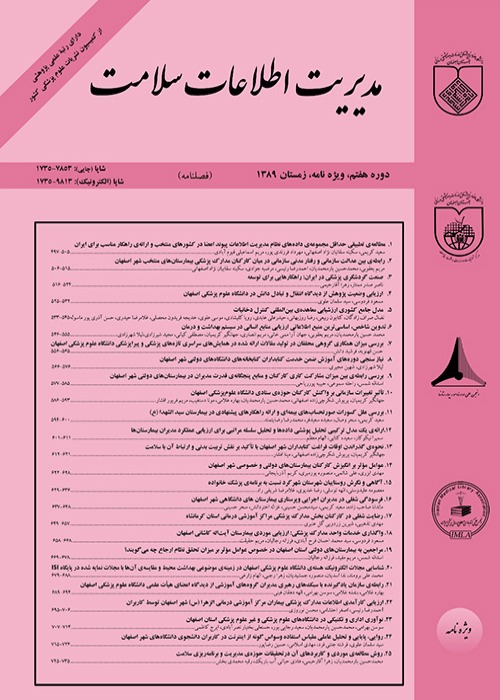The Patient Safety Culture in Fatemeh Zahra Hospital of Najafabad, Iran
Author(s):
Abstract:
Introduction
Health care organizations, especially hospitals, must focus on patient safety as their main strategy. Cultural change is the most important challenge that they are faced with in creating a safe system. The present article aims to improve the patient safety culture with an assessment of the safety in Fatemeh Zahra Hospital, Najafabad, Iran. Methods
This descriptive and cross-sectional research was conducted in 2010. Patient’s safety culture was measured using the Persian adaptation of the Hospital Survey on Patient Safety Culture. This survey was validated by the opinion of 15 experts. The reliability of the questionnaire was determined by Cronbach’s alpha and was 0.846. The questionnaire was sent to all medical employees of Fatemeh Zahra Hospital. Data were analyzed with t-test and one-way ANOVA by SPSS Software. A P-value of less than 0.05 was considered as statistically significant, and 95% confidence interval was calculated. Results
Overall, 196 of the 350 individuals responded to the surveys. The overall response rate was 56%. Supervisor expectations and actions gained 76% of all scores, teamwork within hospital units 75%, organizational learning 73%, feedback and communication about error 70%, transitions 69%, communication openness 68%, management support 65%, teamwork across units 62%, non-punitive response to error 54%, and staffing gained 48%. 64% of all employees had no reports of error. The mean patient safety score was 3.36 (out of 5). According to t-test results, there was no significance difference between patient safety scores in direct and indirect contacts with patient (P = 0.373). Moreover, according to the results of ANOVA, there was a significant difference between the scores of the maternity department and midwifes, and other wards and employees (P < 0.000). There was no significant difference between the patient safety culture scores of employees of different wards, work experience in the ward (their current place of work), work experience in the hospital, and type of contact with patients (P < 0.05). Conclusion
Although the total score of patient safety culture was acceptable, non-punitive response to error, staffing, teamwork across units, and management support are in need of immediate intervention. The hospital can improve the patient safety culture by planning and taking action in these areas.Keywords:
Language:
Persian
Published:
Health Information Management, Volume:9 Issue: 6, 2013
Page:
895
magiran.com/p1112924
دانلود و مطالعه متن این مقاله با یکی از روشهای زیر امکان پذیر است:
اشتراک شخصی
با عضویت و پرداخت آنلاین حق اشتراک یکساله به مبلغ 1,390,000ريال میتوانید 70 عنوان مطلب دانلود کنید!
اشتراک سازمانی
به کتابخانه دانشگاه یا محل کار خود پیشنهاد کنید تا اشتراک سازمانی این پایگاه را برای دسترسی نامحدود همه کاربران به متن مطالب تهیه نمایند!
توجه!
- حق عضویت دریافتی صرف حمایت از نشریات عضو و نگهداری، تکمیل و توسعه مگیران میشود.
- پرداخت حق اشتراک و دانلود مقالات اجازه بازنشر آن در سایر رسانههای چاپی و دیجیتال را به کاربر نمیدهد.
In order to view content subscription is required
Personal subscription
Subscribe magiran.com for 70 € euros via PayPal and download 70 articles during a year.
Organization subscription
Please contact us to subscribe your university or library for unlimited access!


